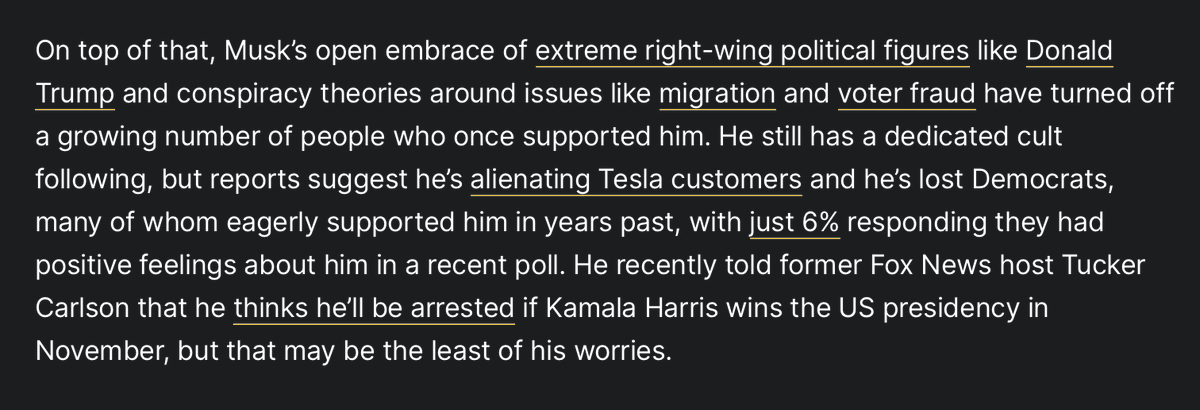Elon Musk unveils Tesla’s Cybercab with elusive production timeline
Musk says the robotaxi will “probably” be in production before 2027 — and is expected to cost less than $30,000.

By Trisha Thadani
October 11, 2024 at 12:37 a.m. EDT
Tesla unveiled its long-anticipated robotaxi, called the Cybercab, late on Thursday at a splashy, highly staged event at Warner Bros. Studios in Burbank, Calif.
CEO Elon Musk said the company’s fully autonomous vehicle, which lacks a steering wheel or pedals, would “probably” be in production sometime in 2026 and is expected to cost less than $30,000.
The Cybercab is a critical product for Tesla, as Musk stakes the company’s future on self-driving technology amid increased competition from established automakers and Chinese manufacturers. The entrepreneur did not provide a clear timeline for when the company would receive the necessary regulatory approval to sell the vehicle or operate it on public roads.
“Let’s not get nuanced here,” Musk said onstage, after an attendee yelled from the audience, asking when the Cybercab would be available.
Musk has made a number of unfulfilled predictions over the past decade that Tesla would soon launch vehicles capable of driving without any human supervision. The company’s vehicles currently on the market have driver-assistance features called Autopilot and Full Self-Driving, but the automaker says they require a human driver to be ready to take over at all times.
Musk on Thursday said he expects the company to start “fully autonomous” driving with Tesla’s existing models, the Model 3 and Model Y, in California and Texas next year. It was not immediately clear whether Tesla had begun the process to apply for the necessary permits to operate a car without a driver in California.
Despite Musk’s long interest in autonomous driving, Tesla has lagged behind other robotaxi companies, such as Alphabet-owned Waymo, which currently operates a ride-hailing service in major cities like San Francisco, Los Angeles and Phoenix.
Musk said during a July earnings call that he wasn’t concerned about getting regulatory approval for the Cybercab, because federal regulators at the National Highway Traffic Safety Administration would be “morally obligated” to approve the vehicle if it proved to be safer than a human driver.
According to the agency, however, all companies looking to operate and sell a “noncompliant vehicle” — without a steering wheel or pedals — “must apply for and receive an exemption from NHTSA before operations on public roads.”
As of Oct. 4, Tesla has not applied for a permit, according to NHTSA. To date, the agency has granted only one general exemption for a fully autonomous vehicle to Nuro, a low-speed delivery robot. It took the company over a year to receive it.
Musk said on Thursday that the Cybercab — a sleek, chrome vehicle with winged doors — will essentially be a “comfortable lounge where you can do whatever you want, and when you get out you’ll be at your destination.” He also unveiled a robot bus that he said can hold more than a dozen people but did not indicate when that vehicle would enter production or was expected to be in widespread use.
Gene Munster, an analyst with Deepwater Asset Management who was at Thursday’s event, said people are going to like the look of the Cybercab but the timeline is “still too far out for skeptical investors to get on board with investing in [Tesla] for autonomy.”
Musk first announced Tesla would unveil a robotaxi earlier this year, shortly after Reuters reported that the company had scrapped production of a vehicle significantly cheaper than its existing lineup. Bloomberg News reported a few months later that the robotaxi event was delayed. Musk, confirming the report in a post on X, said the company needed extra time to make an important “design change to the front, and extra time allows us to show off a few other things.”
/cdn.vox-cdn.com/uploads/chorus_asset/file/25670518/Robovan_73.jpg)


 Arrive to the Party in a Toaster.
Arrive to the Party in a Toaster. aka non-existent production timeline.
aka non-existent production timeline.







